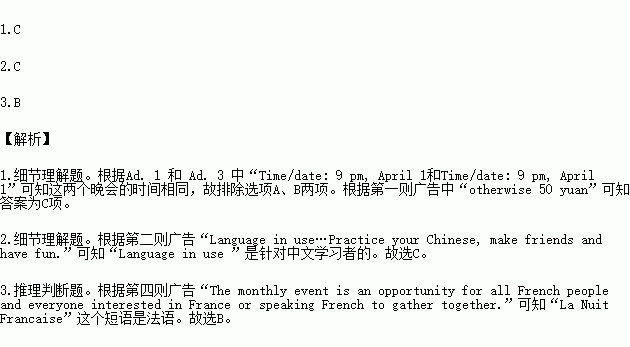题目内容
阅读理【解析】
共20题 每题2分 共40分
Ad. 1
April fool’s party
On Friday, April 1, Inner Affair goes back to the days of funk! Classic Tunes from the 70’s and 80’s by DJs Den & Sion. 9pm till late.
Tickets: Free entrance for those in costume, otherwise 50 yuan (US$6)
Time/date: 9 pm, April 1
Place: Inner Affair, 1/F Qiankun Dasha, 6 Sanlitun Xiliujie, Chaoyang District
Tel: 8454 0321
Ad. 2
Language in use
Enjoy free in house coffee, tea and beer as well as music and dancing. Practice your Chinese, make friends and have fun.
Time/date: 7 to 9 pm, March 25
Place: Language In Use Club, 2/F, Science Fortune Center, 8 Xueqing Lu, north of Xueyuan Lu, Haidian District
Ad. 3
The “worst” party
Organized by Ozone Productions, the party is set to be “the worst ever”, with the lamest music from the 60s, 70s and 80s. Special prizes will be awarded to the worst dressed or for bad fashion sense.
Tickets: Free entrance
Time/date: 9 pm, April 1
Place: Pula Pula, Tianze Lu, Oriental Seven Colours Plaza, Chaoyang District
Tel: 64668575
Ad. 4
La Nuit Francaise
Again on the 2nd Thursday of the month La Nuit Francaise will be held at Le Rendezvous. The monthly event is an opportunity for all French people and everyone interested in France or speaking French to gather together.
The evening features three glasses of wine and canapes for participants and a special exhibition.
Time/date: 7 to 10 pm, April 14
Place: Le Rendezvous, 3 Gongti Beilu, across from the Pacific Century Plaza, Chaoyang District Tel: 64629110
Ad. 5
Marco V
Dutch DJ Marco V drops by Banana for a gig which is supported by Hong Kong’s DJ Spark.
Marco V has been around for many years, as an inventive, style blending deejay and a successful and devoted producer. His spinning is energetic, crowd pleasing and never sees an empty dance floor. He was ranked No. 15 in this year’s international DJ MAG DJ Top100.
Tickets: 40 yuan (US6) at the door, both include a free drink
Time/date: 10 pm to 4 am, March 31, April 1
Place: Banana, in the lobby of the Scitech Hotel, 22 Jianwai Dajie, Chaoyang District
Tel: 65283636
1.Which of the following is NOT true of Ad. 1 and Ad. 3?
A.The two parties will be held on the same day.
B.The two parties will be held at the same time.
C.The entrance fees of the two parties will not be charged.
D.Some old music will be played at the parties.
2.Which of the following is intended for the Chinese learners?
A.Marco V.
B.La Nuit Francaise.
C.Language in use.
D.The “worst” party.
3.We can infer that______.
A.Marco V is a newly established band
B.La Nuit Francaise may be French words
C.the “worst” party will attract a lot of college students
D.you will enjoy free drink at April fool’s party

